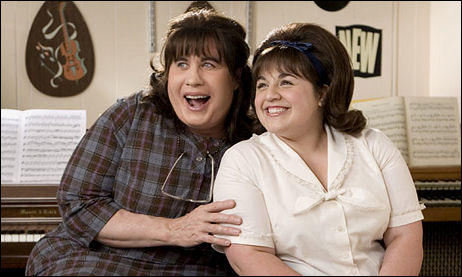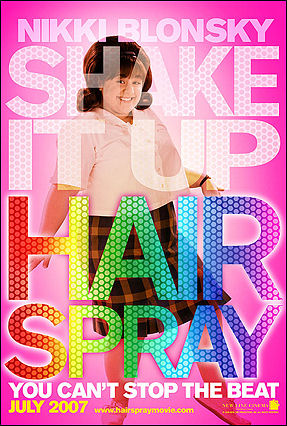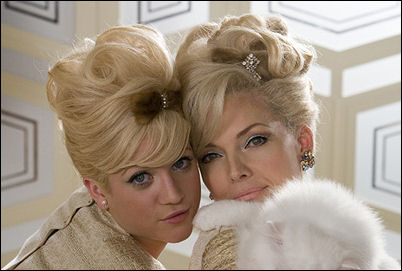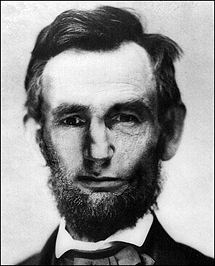“Though profitable for the last nine years, Universal has been noticeably short on blockbusters to call its own,” N.Y. Times reporters Michael Ciepley and Brooks Barnes observe in the 7.16 issue.
“That is largely by design. In a strategy that is starkly different from other top film studios, [studio chief] Ron Meyer has determined that Universal should stay well behind the leaders, allowing the flashiest and most expensive projects — and typically the biggest payoffs — to go elsewhere.
”We gauge ourselves to be in the middle,’ Meyer said. Universal currently ranks last among major studios at the domestic box office and hasn’t placed higher than third in the last seven years.”
How does Meyer’s “stay in the middle” strategy square with the $175 million spent on Uni’s Evan Almighty, which every box-office handicapper considers a flat-out flop in relation to cost? Evan “will lose money for both Universal and its financing partner, Gun Hill II,” Ciepley and Barnes report, “though not a large amount,” says Meyer.
So goes a noteworthy piece about a mild-mannered studio honcho pursuing a prudent, mild-mannered filmmaking policy. Apologies to Ciepley and Barnes, but it nearly put me to sleep. I had to repeatedly stab myself with a push pin in order to stay awake.
Day: July 15, 2007
Denby on “Hairspray”
“I admire John Travolta, but using this movie star, rather than the [Broadway stage version]’s Harvey Fierstein, as Edna Turnblad, is an idiocy on the same level as replacing Julie Andrews with Audrey Hepburn for the movie version of My Fair Lady, declares New Yorker critic David Denby.

New Yorker illustration by Jonas Bergstrand
“Both Fierstein and Divine, who played Edna in the [1988 John Waters] movie, worked as female impersonators who confidently let us in on the joke. In the show, when Fierstein held forth on life and love and the Gabor sisters in his basso absurdo — a testosterone-drenched Bensonhurst snarl — he was not a man pretending to be a woman; he was a man openly playing a woman and speaking in his own voice.
“But Travolta does a wistful imitation of the female sex. Buried in a full-body fat suit and various silicone prosthetic appliances, he looks rounded, smooth, and cute, rather like Miss Piggy, and he speaks in a light, high female voice — he sounds a little like Robin Williams in Mrs. Doubtfire, without the lilt.
“The role demands exaggeration rather than modesty, yet Travolta, with a misbegotten sense of duty, tries to give an authentic performance as a working-class Baltimore housewife of forty-five years ago — a shy, guarded woman who is embarrassed about her weight. It√ɬ¢√¢‚Äö¬¨√¢‚Äû¬¢s a touching attempt, but the lunatic joke that started with Divine has almost vanished.”
Travolta’s Pickup Lines
The Newark Star Ledger‘s Stephen Witty has written the following about some overworked repartee used by John Travolta:
“Here is the first paragraph from a story by Jesse Green on the front page of the New York Times‘ Arts & Leisure section for Sunday, July 15:
“We had only just met, but John Travolta, big and handsome and hypnotic, was fondling the lapel of my navy blue blazer. ‘Ooh, what a great idea to match this with a cobalt blue shirt,’ he cooed. ‘I wouldn’t have thought of that.'”
Here is the first paragraph from a story I wrote for the Star-Ledger‘s Spotlight section on June 13, 1999:
“John Travolta is on his knees in a Manhattan hotel suite, tentatively touching my shirt. “I just got to tell you I am completely inspired,” he says. ‘This is a different style, the two-toned shirt with this tie and the suit — what is this, navy blue?'” He feels the material. ‘Marvelous. Honestly gorgeous.’
Which proves one thing, I suppose, and one thing only: When it comes to wooing journalists, Johnny T has got to come up with some new pickup lines.”
Blanchett Dylan
Unlike The Envelope‘s Tom O’Neil, who sharply criticized this 7.13 I’m Not There YouTube clip that he linked to earlier today, I don’t have a big problem with Cate Blanchett‘s inhabiting of a 1964-ish Bob Dylan. I find her voicings and mannerisms intriguing, curious…oddly cool.
I also love that it’s been shot in black-and-white, and that David Cross is such a convincing looking Allen Ginsberg.
I was told last May that the reason that Todd Haynes‘ long-awaited film wasn’t submitted to Cannes was that it was long (in the vicinity of three hours) and unwieldly with too many hard-to-place strands. I’m Not There will presumably ge given a berth at the Toronto Film Festival, with the Weinstein Co. apparently intending to open it on 11.21. (The IMDB says 9.21, but that can’t be right.) Many of the early fall prestige films are starting to be shown now, and I’m kind of wondering why I haven’t heard about any I’m Not There screenings.
The other five Dylans are being played by Christian Bale, Marcus Carl Franklin, Richard Gere, Heath Ledger and Ben Whishaw.
Hairspray
There will be no hating on Adam Shankman‘s Hairspray (New Line, 7.20) by me. It’s a spunky early ’60s musical with “fun” performances (i.e., spirited by way of pronounced insincerity), dead-on retro clothes and hair styles, some well choreographed musical numbers and a few laughs here and there. The trick is to watch it without getting bored or suffering a major migraine. I was going through my usual movie-agony spasms (leaning forward, hands covering bottom half of face, quiet groaning, frowning) but I’m a sorehead who doesn’t get musicals, right?

John Travolta, Nikki Blonsky
Hairspray is wafer thin, full of shit, repetitive and broader than a barn door but it won’t give you cancer or indigestion or anything along those lines. Standards are always put aside when a robust musical comes along and says with a wink, “Do you get where we’re coming from? That we’re all about singing, dancing, winking and arched eyebrows within the prism of early ’60s nostalgia and culturally refer- enced air quotes? Of course you do! So relax and enjoy.”
The fact that Hairspray is a mildly amusing one-note crock isn’t bothering the critics so far. (It has a 100% Rotten Tomatoes rating as we speak.) They’re calling it entertaining goodtime fizz because (a) their taste buds are corroded or (b) they know the middle-class mall crowd loves easy-to-get retro jukebox pablum, and they don’t want to risk seeming elitist or clueless. Or both.
The original 1988 John Waters film of Hairspray (not a musical) was pat and shallow in a mocking-retro sort of way, and the Hairspray B’way musical was the same thing with big-heart songs and dance numbers. Now comes a big-screen musical version that follows the drill with a John Travolta fat-suit performance that’s moderately okay, a spunky lead-girl performance by Nikki Blonsky and a couple of good-sport turns by Michelle Pfeiffer and Christopher Walken so…what’s not to like? It’s fine.

Which it is. As long as you don’t mind totally pissing away the time it takes to watch it. As long as you can roll with the fizz and the bullshit and the gay Tin Pan Alley attitude. When it comes to musicals I’m more into Once or Hair or Cabaret or Carousel. Shows that came from something strong and real in the first place, and aren’t so much into going “wooooh!”
Hairspray is set in a 1962 Baltimore that existed in some ways (the hair styles, clothing, cars and sets are perfect) and never existed in others. Cute bubbly fat girls like Blonsky (the truth is that she’s dangerously obese) never, ever hooked up with slim good-looking guys back then. (It doesn’t happen today either.) People who knew good music were into Little Richard and Jackie Wilson, but interracial socializing was rare and interracial dating wasn’t noticable until the late ’60s. The movie has the surface details down, but too much of the inside stuff is fanciful tripe.
Blonsky plays Tracy Turnblad, a perky high-schooler who dreams about dancing and becoming famous on a local rock-music dance show called the Corny Collins Show. Her mom Edna (Travolta) is more obese as Tracy, and her good-natured dad (Walken) runs a quirky toy and curio store. Tracy has the hots for Link Larkin (Zac Efron) after laying eyes during an audition to replace a Corny Collins dancer. Her relationship with Larkin pisses off the frosty blonde Amber Von Tussle (Brittany Snow) and her frosty blonde mother Velma (Michelle Pfieffer) somewhat, but what really throws them off-balance is Tracy’s notion that the white-bread show should allow black kids to dance also.

Brittany Snow, Michelle Pfeiffer
Blonsky is very good and talented and likable, but she looks like a smiling little beach ball in a cartoon. I realize I’ve got a rep of being Jabbaphobic, but I really and truly don’t have a problem with largeness as a rule. Plump is cool and fat happens, but extreme obesity is an affliction. Am I lying? To me a seriously obese person is like a drunk staggering around with a bottle of Jack Daniels.
Travolta has been telling interviewers that he tried to play Edna as a real woman and not as a guy giving a drag performance. That’s true as far as it goes but it’s mostly smoke because Travolta isn’t the maestro here — Shankman is — and the scheme of the movie blocks any interest in real-people behavior. Edna emotes within the broad-ass emotional framework of a stage musical, but there’s a ceiling with this kind of thing.
The bottom line is that you have to understand, agree with and follow certain rules of engagement in order to enjoy Hairspray. Maybe the reason I couldn’t have fun is that I understand the rules all too well.
Bush’s apology
“The people trusted me with an important position. I didn’t live up to expectations. If only I had kept my promise to go after the thugs who attacked us on 9/11, because now I’ve made Osama and Al Qaeda stronger. I know my false claim about Al Qaeda’s ties with Iraq led to Iraq’s being tied down by Al Qaeda. I see now that my bungled war on terror has created more terror, empowered Iran and made America less secure. Oh, yeah, and I’m sorry I broke the military.” — an imagined letter of apology from George W. Bush, inspired by a confession written by Beijing’s former FDA-type regulator Zheng Xiaoyu before his execution last Tuesday, and written by N.Y. Times columnist Maureen Dowd.
Cell-phone movies
“If there’s a specter that’s haunting Indiewood and Hollywood alike, it’s the shambling figure of [a] semi-shaved, post-collegiate 22-year-old watching movies on his cellphone,” Salon‘s Andrew O’Hehir wrote a couple of days ago.

Why do people keep bringing this up as the next big shift in viewing habits? Cell-phone moving images are strictly about fast and short and move on to the next distraction. If I’m stuck or locked down somewhere I might be persuaded to watch a news show on a iPhone for 20 or 30 minutes, but sustained viewing of anything on a screen that size makes your eyeballs throb. Seriously — does anyone know any 12 or 14 year-olds who prefer iPhone-sized screens to watch movies on? (As opposed to music videos, YouTube clips, amateur porn, movie trailers, etc.)
There’s a certain coolness that comes with watching movies on iPhones if you’re in the mood to do that, but step back and consider the obvious — the size of an iPhone screen makes watching whole movies on them time and again (week in and week out, a regular viewing habit) fairly ridiculous.
“Now, I don’t know anybody who has actually watched a feature film on a telephone,” O’Hehir goes on, “and I’m not even sure it’s feasible. But three different people in the film industry have mentioned the idea to me within the last week, and the question of its present-tense plausibility is clearly not relevant.
“What people are really saying is that a big, weird change is coming. They don’t quite understand it and they can’t do anything to stop it, but they’re worried that the whole business of selling $10 tickets to go sit in a dark room with some strangers and a movie projector is suddenly going to seem like Thomas Edison‘s windup gramophone and its wax cylinders.”
Obviously the theatrical experience doesn’t rule like it used to. It’s still a preferred option, but “option” is the governing term. Movie-watching can happen anywhere these days, in any kind of environment that allows for semi-darkness or at least shade. I just can’t imagine anyone actually preferring to watch full-length movies on screens that are less than 15″ inches wide. I don’t even like that very much. I’m okay with watching a film every so often on my 17″ Gateway, but not as any kind of habit. I’m not even particularly comfortable with 27″ flat screens. I mean, they’re tolerable but in no way preferred.
My own viewing tastes and preferences from (b) on down probably synch up with those of any movie-lover with a semblance of taste (and I’m including 12 year-olds in this equation): (a) Private screening rooms in Los Angeles or New York or any big-league city, (b) Recently constructed ace-level theatres (Arclight, Landmark, Bridge, Egyptian, Aero, etc.) with stadium seating and all the other high-standard trimmings, (c) high-def 16 x 9 flat panel viewing off Blu-Ray or HD-DVD, (d) my own Sony 36″ flat screen, and (e) my 17″ Gateway laptop.
Cell phone viewings aren’t taken seriously in this corner. They’re not even in the “hey, maybe” category. And forget small-screen TVs. I’ll consider the notion of seeing a film in some schlubby run-of-the-mill theatre like the New Beverly or the Regency Fairfax or the Monica plex on 2nd Street, but only if backed into a corner. On the other hand, the Vista in Silver Lake is pretty cool.
Danse macabre celebrities
“We’re all on the web, weighing various kinds of data we get — eBay listings, blog posts, Craigslist solicitations — and trying to read between some pixels, and connect others,” writes N.Y. Times reporter Virginia Heffernan. Her topic is a strange mass compulsion to indulge in dispassionate visual dissection of celebrities, which even sophisticated journalists are prey to. Not something akin to fan behavior, but obsession with a white lab coat — a kind of coldly analytical scientific curiosity.

“I don’t expect we’ll break any big news reading PerezHilton.com,” she explains. “But maybe we’re not entirely wasting our time; we’re practicing interpreting images from the new close-range, high-def magazines and websites.
“In any case the danse macabre that stars now do with the paparazzi, who appear to lurk everywhere, must be logistically maddening and emotionally draining. Every trip to the grocery store is a performance piece; every day at the beach is a soft-porn movie.
What’s more the consumers of the resulting plays, movies, video projects and photographs — that’s us — are not primarily looking to be entertained or transported. We’re just looking for data, more and more data, the more raw the better.
“Someday we may need nothing but zeros and ones to give our prognostications. And then we really won’t need the star herself. But for now a young star is in a strange place. To become a specimen, a lab slide, a piece of data: surely this is not what people dream of when they quit high school, take singing lessons and move to Hollywood.”
Of all the sites she mentions, I like idontlikeyouinthatway the best. All the celeb gossip-and-photo sites are cruel and catty, but this one’s a little more so. The way it dismisses Cameron Diaz is beyond savage; it’s kind of sociopathic.
Neeson’s Lincoln Still Floundering
Liam Neeson recently spoke to London Times profiler Tom Charity, and there’s not a single…wait, there is a glancing mention of what may be Neeson’s finest unplayed role, which would be Abraham Lincoln during his White House years. But it’s not enough to suit me. Neeson is obviously the right height (6’4″), the right age (55) and the right everything else (acting chops, an aura of solemn rectitude, wiry frame, similar bone structure) in order to fill Lincoln’s shoes and reanimate him every which way.


Abraham Lincoln; how Neeson might look in the role
A year and a half ago Neeson told me about forthcoming plans for Steven Spielberg to direct an adaptation of Doris Kearns Goodwin‘s “Team of Rivals: The Political Genius of Abraham Lincoln,” which at the time was being adapted into screenplay form by Paul Webb.
This movie really, really has to be made. If Spielberg can’t or won’t do it (i.e., if it scares him), he should have the good grace to step away and let somebody else carry the ball.
WTC asbestos
Gawker posted this 1981 magazine ad (“…around the time that asbestos manufacturers were starting to take serious heat for their cancer-causing product”) four or five days ago; I didn’t happen upon it until earlier today.

